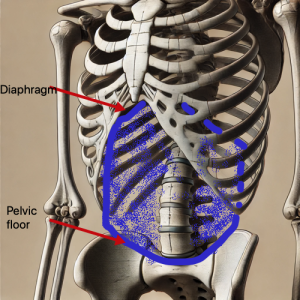The core capsule, often referred to as the “Core,” is the center of our physical stability and movement. It consists of a group of muscles that work together to stabilize the spine, support posture, and coordinate the body’s movements. In this article, we will focus on four essential components of the core: the deep abdominal muscle transversus abdominis, the deep back muscles, the diaphragm, and the pelvic floor muscles.
The 4 Important Parts of the Core

- Transversus Abdominis
The transversus abdominis (TVA) is the deepest of the abdominal muscles and encircles the trunk like a corset. Its primary function is to stabilize the spine and pelvis. The transversus abdominis plays a crucial role in maintaining intra-abdominal pressure, which in turn relieves and protects the spine.
A study by Hodges et al. (1999) showed that the transversus abdominis is one of the first muscles naturally activated when stability is required, for example, when preparing for movement or lifting objects. A well-trained TVA is therefore essential for preventing back pain and promoting good posture.
During pregnancy, the transversus abdominis stretches to make room for the growing baby and becomes weakened. After pregnancy, the body must relearn how to engage and activate this important muscle. You can learn how to do this in the article on training the deep abdominal muscles.
- Deep Back Muscles
The deep back muscles, including the erector spinae and multifidus muscles, run along the spine and are responsible for maintaining and stabilizing the spine. These muscles enable us to stand upright, bend, and twist.
Strong deep back muscles are crucial for avoiding injuries and chronic back pain. Studies have shown that targeted exercises to strengthen these muscles, such as back extension exercises and stabilizing movements, can improve spinal stability and reduce back pain symptoms.
During pregnancy, the body’s center of gravity shifts forward, leading to altered strain on the back muscles. These muscles must work harder to support the additional weight and compensate for the changed posture.
- Diaphragm
The diaphragm is the primary muscle of respiration and also plays an important role in stabilizing the core. It separates the chest cavity from the abdominal cavity and works closely with the deep abdominal muscle transversus abdominis and the pelvic floor muscles to regulate abdominal pressure. Efficient breathing techniques that involve the diaphragm can help improve core stability and enhance physical performance.
A study by Kolar et al. (2009) showed that dysfunctional breathing techniques, where the diaphragm is not optimally utilized, can lead to reduced core stability and an increased risk of muscular imbalances. Breathing exercises that activate the diaphragm are therefore a valuable addition to any core training program.
During pregnancy, the diaphragm is pushed upward as the growing baby takes up more space in the abdominal cavity. This change can affect breathing capacity and efficiency.
- Pelvic Floor Muscles
The pelvic floor muscles form the base of the pelvis and support the pelvic organs. These muscles play a vital role in controlling bladder and bowel function as well as stabilizing the core.
The pelvic floor works closely with the transversus abdominis and diaphragm to ensure a strong and stable core.
A strong pelvic floor is particularly important for women after childbirth, but also for men, to avoid incontinence and other pelvic floor issues. Studies have shown that targeted pelvic floor exercises not only improve the functionality and strength of these muscles but also support overall core stability.
During pregnancy, the pelvic floor experiences significant strain due to the growing baby and hormonal changes, which make connective tissue softer and more elastic. This strain can weaken the pelvic floor muscles, leading to incontinence and reduced core stability.
Integration and Training
The four muscle groups mentioned work synergistically to form a stable and functional core. An effective training program should include exercises that target all these muscles and promote their cooperation. Only when all four parts of the core are intact and activated can a stable center be achieved.
Challenges for the Core After Pregnancy
After childbirth, the body faces the task of restoring the function and stability of the core muscles. Many women report reduced core stability, back pain, and general weakness in the core area. Inadequate postnatal recovery can lead to long-term issues such as chronic back pain and pelvic floor problems.
During pregnancy, the body adapts to the growing baby, which has significant effects on the core muscles. The muscles stretch and weaken to make room for the baby. In particular, the rectus abdominis muscles (the “six-pack” muscles) separate, a phenomenon known as diastasis recti. Diastasis recti must be closed or stabilized after childbirth.
Methods to Strengthen the Core After Pregnancy
Core training after pregnancy should be gradual and systematic. A multimodal approach that includes both physiotherapy and specific exercises has proven particularly effective. Here are some of the key methods:
- Physiotherapy
Physiotherapy can play a crucial role in restoring core stability. A study by Kari Bø et al. (2016) showed that an individually tailored physiotherapy program designed for postpartum women can significantly improve core stability and reduce back pain.
- Specific Exercises to Strengthen the Core Muscles
Targeted exercises to strengthen the deep abdominal and back muscles are essential. An example of this is exercises that engage the transversus abdominis (the deepest abdominal muscle). A study by Stuge et al. (2004) found that specific stabilization exercises that involve this muscle are particularly effective in improving core stability and reducing back pain.
You can find an introduction to exercises for the deep abdominal muscles in the article: Training the Deep Abdominal Muscles.
- Incorporation of Pelvic Floor Exercises
The pelvic floor is closely linked to the core and should be included in exercises. Exercises to strengthen the pelvic floor can contribute to improved overall stability and prevent issues such as incontinence. A systematic review by Dumoulin et al. (2018) emphasized the importance of pelvic floor exercises for postpartum rehabilitation and demonstrated their effectiveness in preventing and treating incontinence.
Here are some pelvic floor exercises.
Long-Term Core Training to Prevent Disease
In the long term, you should continue to integrate exercises to strengthen the core into your daily routine, even after the initial postpartum recovery phase and beyond a postpartum exercise course. Postpartum recovery doesn’t end with a postpartum course.
Getting back to full fitness after pregnancy can take 2-3 years. This doesn’t mean you have to avoid sports for that long, but you do need to do the right exercises and possibly postpone certain sports while focusing on others. Until your core can fully perform its stabilizing function again. Otherwise, (serious) injuries may occur.
In particular, during the first year, you should avoid training the rectus abdominis (sit-ups), heavy lifting and carrying, jogging, running, and jumping. Otherwise, you could cause damage to your body that won’t go away easily. Unfortunately, I didn’t know this after my first pregnancy and ended up with a herniated disc.
Here you can find exercises that you can do after pregnancy: Postpartum Exercises.
And here are additional exercises for the whole body during the first and second years after childbirth.
Conclusion
The core plays a crucial role in the stability and functionality of the body, especially after pregnancy. Changes during pregnancy can weaken this muscle group, requiring a targeted recovery phase postpartum. Scientifically-based approaches, including physiotherapy, specific exercises, and pelvic floor exercises, are essential for restoring and maintaining long-term core muscle health. Comprehensive and continuous care of this muscle group is vital and can help prevent long-term problems and improve quality of life.
References
Dumoulin C, Cacciari LP, Hay-Smith EJC. Pelvic floor muscle training versus no treatment, or inactive control treatments, for urinary incontinence in women. Cochrane Database Syst Rev. 2018 Oct 4;10(10). doi: 10.1002/14651858.CD005654.pub4. URL: https://www.ncbi.nlm.nih.gov/pmc/articles/PMC6428911/pdf/main.pdf
Mørkved S, Bø K. Effect of pelvic floor muscle training during pregnancy and after childbirth on prevention and treatment of urinary incontinence: a systematic review. Br J Sports Med. 2014 Feb;48(4):299-310. doi: 10.1136/bjsports-2012-091758. Epub 2013 Jan 30. PMID: 23365417. URL: https://bjsm.bmj.com/content/48/4/299.long
LoMauro A, Aliverti A. Respiratory physiology of pregnancy: Physiology masterclass. Breathe (Sheff). 2015 Dec;11(4):297-301. doi: 10.1183/20734735.008615. PMID: 27066123; PMCID: PMC4818213. URL: https://www.ncbi.nlm.nih.gov/pmc/articles/PMC4818213/pdf/EDU-0086-2015.pdf
Hosseinifar M, Akbari M, Behtash H, Amiri M, Sarrafzadeh J. The Effects of Stabilization and Mckenzie Exercises on Transverse Abdominis and Multifidus Muscle Thickness, Pain, and Disability: A Randomized Controlled Trial in NonSpecific Chronic Low Back Pain. J Phys Ther Sci. 2013 Dec;25(12):1541-5. doi: 10.1589/jpts.25.1541. Epub 2014 Jan 8. PMID: 24409016; PMCID: PMC3885835. URL: https://www.ncbi.nlm.nih.gov/pmc
Frank, Nicole (2018). Die ersten Schritte eine Rektusdiastase in den Griff zu bekommen. In: Nicole Frank Physiotherapie. URL: https://www.nicole-frank-physiotherapie.de/die-ersten-schritte-eine-rektusdiastase-in-den-griff-zu-bekommen. (date: 18.07.2024)

Sonja ist Ernährungswissenschaftlerin und promovierte Epidemiologin mit langjähriger Erfahrung in der Gesundheitsforschung. Seit der Geburt ihrer beiden Kinder 2019 und 2023 beschäftigt sie sich intensiv mit dem Thema Rückbildung und der Thematik, wie man wieder einen gesunden und schönen Körper mit stabiler Mitte nach der Schwangerschaft bekommen kann. Sie möchte Euch helfen, nach der Schwangerschaft wieder fit zu werden!
